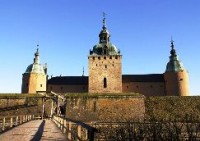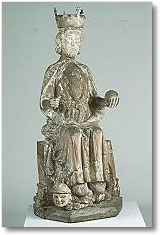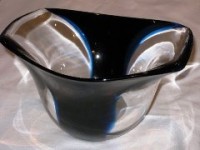Kalmar Castle, in Sweden, is tranquil now, and murmuring tourists make the only sounds on cobblestones that rang with horses’ hooves and marching feet 800 years ago. The mighty fortress, where swords clashed in bloody battles, was replaced with a castle in the 16th century by King Gustav Vasa. This is one of Sweden’s  best-preserved Renaissance castles, complete with moats, dungeons, and secret passages. Copper-roofed and topped with gilded crowns, the castle perches on an island in Kalmar Sound, on Sweden’s southeastern coast. It’s open daily for tours from April through August.
best-preserved Renaissance castles, complete with moats, dungeons, and secret passages. Copper-roofed and topped with gilded crowns, the castle perches on an island in Kalmar Sound, on Sweden’s southeastern coast. It’s open daily for tours from April through August.
The castle is next to the charming town of Kalmar, a 45-minute flight from Stockholm, 4- 1/2 hours by train through a landscape of birch forests, lakes, and well-tended farmhouses.
Kalmar, strategically set on the edge of the Baltic Sea, (Kalmar map) was important in centuries past as a trading post and rich farming and fishing region. Walking around the Old Town (Gamla Stan), I felt thrust back in time, passing bright blue and yellow cottages and stone houses built 300 years ago along the cobbled streets. In Kvarnholmen, the new town (“new” being a relative term here; this area dates from 1647), an impressive Baroque cathedral stands on the main square, Stortorget.
 There’s an interesting modern museum, Kalmar Konstmuseum, where Swedish artworks are displayed, but for a fascinating glimpse of history, the Kalmar Lansmuseum is a must. Here you can see relics from a battleship that sank in 1676 and wasn’t discovered until 1980, at the bottom of the Baltic Sea. Divers found incredible treasure — gold, bronze cannons, carved wooden statues, and thousands of artifacts showing how people lived when the ship went down in battle. The divers rescued bones, buckles, buttons, coins, gloves, even a violin.
There’s an interesting modern museum, Kalmar Konstmuseum, where Swedish artworks are displayed, but for a fascinating glimpse of history, the Kalmar Lansmuseum is a must. Here you can see relics from a battleship that sank in 1676 and wasn’t discovered until 1980, at the bottom of the Baltic Sea. Divers found incredible treasure — gold, bronze cannons, carved wooden statues, and thousands of artifacts showing how people lived when the ship went down in battle. The divers rescued bones, buckles, buttons, coins, gloves, even a violin.
My hotel, the Slottshotellet, was across the street from a leafy park and within easy walking distance of the castle. Dating from 1864, its 44 rooms have period furnishings with modern comforts. The service was warm and friendly, the buffet breakfast was great. The hotel restaurant, the Vänner, has tables on the flowery terrace in summer so you can dine by the roses. Rooms for two, with breakfast, are around 1590 Swedish krona (the current exchange rate is 8 krona to $1).
Other hotels I recommend are the Calmar Stadshotell, in an Art Nouveau building on the main square, and Clarion Packhuset, an atmospheric place with rooms overlooking the water. The Clarion is a good value; in addition to a sauna, free parking, and breakfast, guests are offered a light evening buffet. The Stadshotell has a restaurant, the Victoria, and a Scottish-themed pub, Pipes of Scotland.
Restaurants abound in this city of 60,000 people. Worth a visit not only for its sandwiches and cakes but for the atmosphere is Kullzenska Cafeet. Its upstairs rooms have much of the original 19th century home decor, complete with comfy sofas and tiled stoves.
 One of the region’s claims to fame is its world-renowned Swedish glassware. Artisans in glass blowing have been crafting their works of high quality in the “Kingdom of Crystal” since the 16th century, when the king started the tradition with artisans from Venice. Several factories are open to tourists. I visited the Orrefors glassworks and came away with new respect for the skills (as well as a beautiful Orrefors bowl).
One of the region’s claims to fame is its world-renowned Swedish glassware. Artisans in glass blowing have been crafting their works of high quality in the “Kingdom of Crystal” since the 16th century, when the king started the tradition with artisans from Venice. Several factories are open to tourists. I visited the Orrefors glassworks and came away with new respect for the skills (as well as a beautiful Orrefors bowl).
Kalmar is in the southern province of Smaland. Thousands of emigrants left the area for America, and their descendants often come in search of their roots. If you’re interested, several websites can help. One is www.genealogi.se/roots.
Near Kalmar, one of Europe’s longest bridges stretches over the water to the island of Öland, a favorite Swedish vacation spot.


Comments